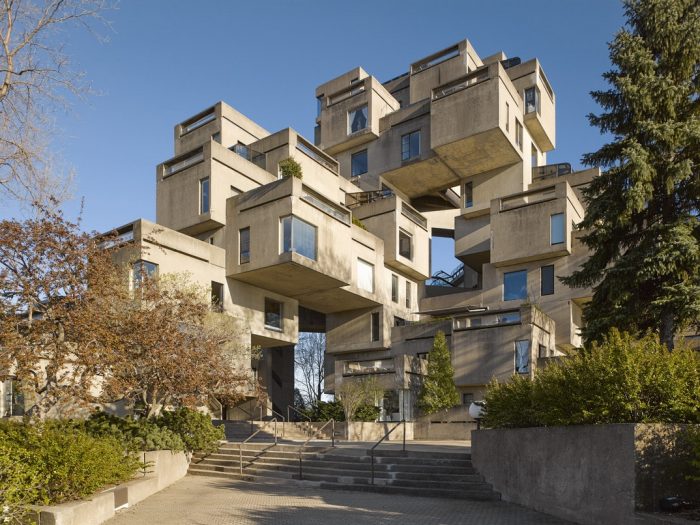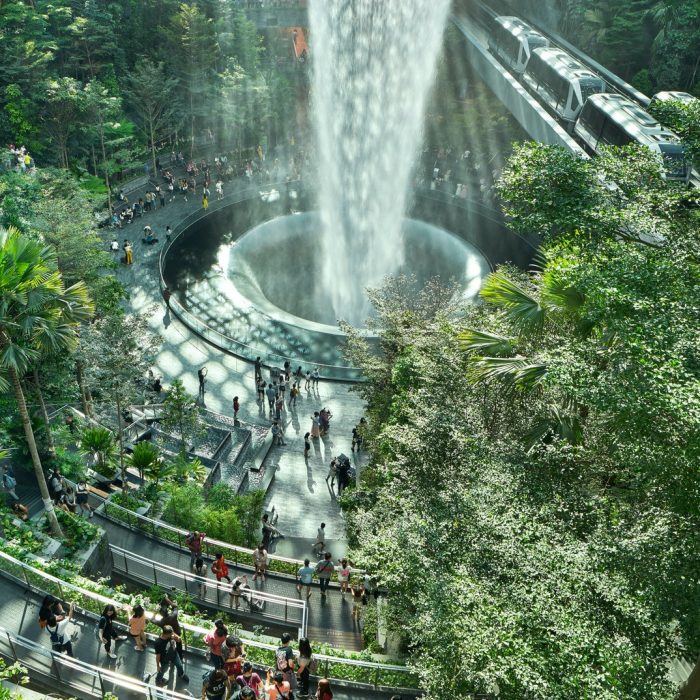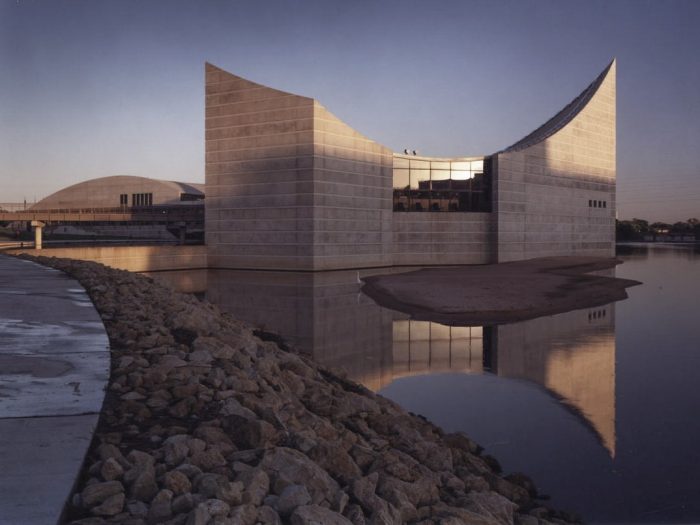
- Permbajtja
- prev
- next
- prev
- next
HIGHLIGHT: MOSHE SAFDIE

Moshe Safdie (Hebrew: משה ספדיה; born July 14, 1938) is an architect, urban planner, educator, theorist, and author who claims Israeli, Canadian and American citizenship. Over a 50-year career, Safdie has explored the essential principles of socially responsible design through a comprehensive and humane design philosophy. Safdie is an important architect of the second half of the twentieth and early twenty-first century because of his multiculturalism, commitment to geographic, social and cultural elements that define a place, and constant search for typological and technological innovation. Safdie's projects include cultural, educational, and civic institutions; neighborhoods and public parks; housing; mixed-use urban centers; airports; and master plans for both existing communities and entirely new cities. Safdie has had projects in North and South America, the Middle East, and throughout Asia. He is most identified with designing Marina Bay Sands and Jewel Changi Airport, as well as his debut project, Habitat 67, originally conceived as his thesis at McGill University. This led to his international career. Safdie is considered a thought leader and his exemplary projects have inspired generations of architects and architecture.
Early life and education
Moshe Safdie was born in Haifa, British Mandate of Palestine (now Israel) in 1938, to a Sephardic Jewish family of Syrian-Jewish and Lebanese-Jewish descent. He was nine years old, living in Haifa, when, on May 14, 1948, David Ben-Gurion proclaimed the Declaration of the Establishment of the State of Israel. Safdie attended Reali High School. He lived in a kibbutz, working in the countryside. He tended goats and kept bees. In 1953, the Israeli government restricted imports in response to an economic and currency crisis, which severely affected Safdie's father's textile business. Consequently, when Safdie was age 15, his father moved the family and immigrated to Montreal, Quebec, Canada. Safdie completed pre-university training at Westmount High School.
In September 1955 he registered in McGill University Faculty of Engineering's six-year architecture degree program. In his fifth year, Safdie was named University Scholar. The following summer, he was awarded the Canada Mortgage and Housing Corporation (CMHC) Scholarship. He traveled across North America to observe housing developments in major cities. In his final year, Safdie developed his thesis titled "A Case for City Living" and described as "A Three-Dimensional Modular Building System". He received his degree in 1961. Two years later, while apprenticing with Louis Kahn, Safdie at age 23 was invited by his thesis advisor, Sandy van Ginkel, to submit his modular project for the World Exposition of 1967, to be held in Montreal. It became known as Habitat 67.
Career
Encompassing more than seventy-five completed buildings, communities, and master plans on three continents and an even greater number of projects and competition entries, Safdie's career has evolved in a series of distinct phases.
In 1964, Safdie established his own firm in Montreal to undertake work on Habitat 67, an adaptation of his thesis at McGill University. Habitat 67 was selected by Canada as a central feature of Expo 67; it pioneered the design and implementation of three-dimensional, prefabricated units for living. Safdie designed the complex as a neighborhood with open spaces, garden terraces, and many other amenities typically reserved for the single-family home, and adapted to a high-density urban environment. This was an important development in architectural history. This seminal project launched the first phase of Safdie's work: A new kind of urbanism.
In the second phase of his career, Safdie established a branch office of his practice in Jerusalem in 1970. During this period, Safdie combined his interests in social activism and advanced technologies with profound respect for historic and regional context. He worked on the restoration of the Old City and the construction of Mamilla Center, linking old and new cities. Other significant works in Israel include the New City of Modi’in, the Yad Vashem Holocaust History Museum, Yitzhak Rabin Center for Israel Studies, Ben Gurion International Airport, National Campus for the Archeology of Israel, multiple projects for Hebrew Union College, and others. During this period, Safdie also worked with leaders in Senegal and Iran.
In the third phase of his career, Safdie received commissions for significant buildings across North America. He took his interest in geometry as a generator of architectural shape in a new direction, combining it with a focus on sensual and symbolic architectural experience, and working to understand clients’ aspirations. He expressed civic and national identities in his cultural projects. Safdie designed the National Gallery of Canada, the Quebec Museum of Civilization, and Vancouver Library Square. Other notable cultural works include: The Khalsa Heritage Memorial Complex, the national museum of the Sikh people in Punjab, India; the United States Institute of Peace Headquarters on the Mall in Washington, DC; the Kauffman Center for the Performing Arts in Kansas City, Missouri; and the Crystal Bridges Museum of American Art in Bentonville, Arkansas.
Safdie's twenty-first century projects are characterized by greater geographic range. He has worked on projects in emerging markets, and brought projects to completion in shorter time spans, at larger scales. These landmark developments include: Marina Bay Sands, a mixed-use resort integrated with Singapore's iconic Skypark; Jewel Changi Airport, a new community-centric airport typology combining marketplace and garden; and Raffles City Chongqing, a mixed-use development featuring over one million square meters of housing, office, retail, transportation, and hotel programs. He created the world's longest ‘Horizontal Skyscraper.’ Safdie and his team have used skybridges and multi-level connectivity to make skyscrapers more accessible.
Practice
Moshe Safdie is the Founding Principal and Lead Designer at Safdie Architects, founded in 1964 to realize Habitat 67. Safdie Architects is a research-oriented architecture and urban design studio active in a wide variety of project types, scales, and sectors. Safdie Architects’ global projects are directed from its headquarters in Boston, Massachusetts, with satellite offices in Jerusalem, Toronto, Shanghai, and Singapore. Projects are designed, managed, and executed by a global team of fewer than 100. The practice is organized as a partnership and operates in the model of an intimate design studio environment. The firm's partners – many of whom joined Safdie after graduation – have been working together for decades.
Within his office, Safdie formed a research program to pursue advanced investigation of design topics. The practice-oriented fellowship explores speculative ideas outside normal business practice constraints. Fellows work independently with Safdie and firm principals to formulate specific proposals and research plans. The salaried position is located in-residence, with full access to project teams and outside consultants. Past fellowships include Habitat of the Future, Mobility on Demand, and Tall Buildings in the City.
Academia
In 1978, after teaching at McGill, Ben Gurion, and Yale universities, Safdie was appointed Director of the Urban Design Program at Harvard University's Graduate School of Design (GSD) and moved to Boston, Massachusetts. He served as Director until 1984. From 1984 to 1989, he was the Ian Woodner Professor of Architecture and Urban Design at Harvard. Safdie continues to work closely with the GSD, frequently teaching design studio; Notably, Rethinking the Humanist High-Rise (2019) and Rethinking Hudson Yards (2017). Safdie regularly travels to, speaks at, and/or Chairs conferences engaged in industry-defining discussions on architecture and beyond.
Personal life
In 1959, Safdie married Nina Nusynowicz, a Polish-Israeli Holocaust survivor. Safdie and Nusynowicz have two children, a daughter and son, born during the inception and erection of Habitat 67. Just before the opening, Safdie and his young family moved into the development. His daughter Taal is an architect in San Diego, a partner of the firm Safdie Rabines Architects; His son Oren is a playwright who has written several plays about architecture. Safdie's great-nephews, Josh and Benny, are independent filmmakers. Safdie and Nusynowicz divorced in 1981.
In 1981, Safdie married Michal Ronnen, a Jerusalem-born photographer and daughter of artist Vera Ronnen. Safdie and Ronnen have two daughters, Carmelle and Yasmin. Carmelle is an artist, and Yasmin is a social worker.
Selected works
-Yad Vashem Holocaust History Museum

The Museum is located on Mount Herzl, the Mount of Remembrance. To preserve the pastoral character of the delicate site and respond to the needs of Yad Vashem, the "body" of the Museum is hidden within the earth, only allowing the elongated central spine to break through the earth and convey a sense of its true scale.
The rebuilding of the Holocaust History Museum at Yad Vashem includes a new visitors’ centre (mevoah), a new history museum replacing the existing museum constructed in 1953, a Hall of Names, a synagogue, galleries for Holocaust art, an exhibition pavilion and a learning and visual centre. In addition, new underground parking and facilities for tour buses are located adjacent to a new entrance piazza.
-Habitat67

Habitat was the major theme exhibition of the 1967 Montreal World Exposition. As a landmark demonstration project, it pioneered a vision for urban housing using the technology of pre-fabricated construction. As a break-through building type that continues to resonate today, Habitat seeks to create a vital neighborhood with open spaces, garden terraces and many other amenities typically reserved for the single-family home, now adapted to a high density city environment.
365 construction modules connect to create 158 residences. These range in size from 600-square-foot one-bedroom dwellings to 1,800-square-foot four-bedroom dwellings. In all, there are fifteen different housing types. Stepped back in their modular placement, each residence has its own roof garden. Play areas for young children are provided throughout the building.
-Changi Airport

Based on the geometry of a torus, the building shape accommodates the programmatic need for multiple connections in the airport setting. At the heart of its glass roof is an oculus that showers water through a primary multistory garden, five stories through to the forest-valley garden at ground level. The core of the program is a 24-hour layered garden attraction that offers many spatial and interactive experiences for visitors. Four cardinal axes—north, south, east, and west—are reinforced by four gateway gardens, which orient visitors and offer visual connections to the internal surroundings and other airport terminals. By night, the glazed facade helps dematerialize the building, revealing the glowing garden within.
-Exploration Place Museum and Educational Center

The design for Exploration Place Museum and Educational Center reshapes the river’s edge to create a one of a kind island exhibition pavilion facing a new public park and waterfront promenade.
Visitors to the Museum enter through a pavilion with a vaulted roof and cross a channel to the exhibition pavilion, surrounded by water and dedicated to the human experience on earth. The two wings of the building are unified by the concave and convex geometric roof forms.